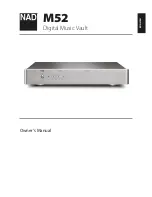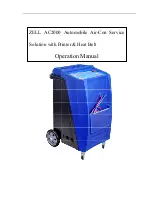
WCB11070 (PDF FORMAT)
16
©
Copyright Eaton Corp. 2007, All Rights reserved.
Figure 11
4.2.2.4 Wear spacers are slotted to allow for in-place removal.
Using a narrow chisel wedged into the slot in the
spacer, as shown in
Figure 11
, pry the wear spacer
until it fractures and is clear to be removed from the
stud. Repeat for the remaining spacers in the set that
is to be removed (one spacer from each stud location).
Be sure to collect
all
wear spacers when
removed. Spacers lodging in between ten-
sioner components could prevent the ten-
sioner from properly engaging or releasing.
4.2.2.5 While supporting the weight of the cylinder/piston
assembly, tighten the locknuts (18)
ONE TURN AT A
TIME
and in a crosswise pattern, until the cylinder is
seated firmly against the clamp tubes. Torque the
locknuts to the appropriate value. See Table 4.
The locknuts (18) must be tightened gradually
and evenly to prevent damage to the brake
components.
4.2.2.6 Reinstall the support bracket if required.
4.2.2.7 Restore any piping or covers removed prior to operat-
ing the tensioner.
4.3
Disassembly Procedures
Ensure that the machinery is and will remain
in a safe position prior to loosening fasteners
or removing the tensioner.
4.3.1
Disconnect the air supply lines and water lines from
the tensioner.
4.3.2
Remove the fasteners that secure the tensioner (and
support bracket, if applicable) to the mounting struc-
ture.
4.3.3
Using soft slings, rig the tensioner and slide the WCB2
off of the gear. Avoid placing slings or straps directly
on the release springs (34).
4.3.4
Transport the tensioner to a clean working area and
position the unit on a flat surface with the mounting
flange (1) facing down.
4.3.5
If the gear (28) requires replacement, remove it from
the shaft with a portable jack, using the threaded
holes in the end of the gear for puller holes. Heating
may be required to ease removal. Replace the gear
and install per Section 2.2.
4.3.6
Match-mark the mounting flange (1), reaction plates
(30), pressure plate (13) and cylinder (19) to one
another prior to disassembly to adequately show the
proper orientation of components and various ports to
one another.
4.3.7
Loosen the locknuts (18) ONE TURN AT A TIME and
in sequence until the release spring force is relieved.
4.3.8
Lift the cylinder and piston off of the studs as an
assembly. Set the assembly aside on a clean, level
area, making sure to avoid damaging the face of the
piston.
4.3.9
Continue removing the remaining components if
required.
4.3.10 Inspect all components using the wear limits in
Table 13 as a reference.
4.3.11 For friction lining replacement refer to Section 4.4 or
4.5.
4.3.12 For wear plate replacement refer to Section 4.6.
4.3.13 Refer to Section 4.7 to replace seals.
4.3.14 Assemble the tensioner per Section 4.9.
















































